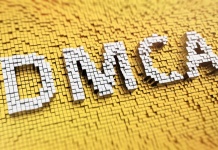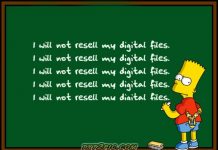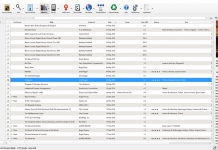 Kevin Kelly’s New York Times Magazine article on the world-wide efforts to create a digital library, Scan This Book! (non-free registration required), discussed earlier by David here and here, seems to work as a catalyst for many original thoughts. (Either that, or I don’t read nearly enough.) Some choice quotes from a discussion at Slashdot:
Kevin Kelly’s New York Times Magazine article on the world-wide efforts to create a digital library, Scan This Book! (non-free registration required), discussed earlier by David here and here, seems to work as a catalyst for many original thoughts. (Either that, or I don’t read nearly enough.) Some choice quotes from a discussion at Slashdot:
There are two types of books: cold (paper-based) books and cozy (paper-based) books. Examples of cold books are the books that you use at work. You have no attachment to these books. They are there to provide information.
Digital books will wipe out the market for cold books. Digital books have one crucial advantage over cold books. You can use a search engine to search the content of a digital book.
…
The opposite of cold books is cozy books. These are books that you read while you are curled up on a comfy sofa or bed. As you sip hot chocolate spiked with whipped cream, you devour every word of the book. You lovingly flip the pages as you quickly follow the heroine of your chick-lit novel.
…
Note that the notions of “cozy books” and “cold books” are relative. A female engineer may consider a book about advanced quantum physics to be a “cozy book” for leisure reading, but a middle-aged housewife may consider a romance novel to be a “cozy book”. The point is that digital books will never eliminate all paper-based books simply because cozy books will continue to survive in the digital age.
http://yro.slashdot.org/comments.pl?sid=185759&cid=15332711
Will all these books and articles require we login to view them first? I think having every book, article, movie, song, etc available for use anytime is a great idea and important for society but I don’t want to have to login and leave a paper trail of everything I’m looking at.
http://yro.slashdot.org/comments.pl?sid=185759&cid=15332297
He is quite literally talking about logging in to a server, where his every movement is followed, but of course a DRM that would phone home would have the same disastrous effect on privacy. Philip Greenspun wrote earlier about how easily data on individuals’ movements can be gathered using mid-1990s technology.
The creator of any given object in Second Life can set bits that say whether or not you can copy/edit/sell that object. The game then enforces those bits. As it is done on the server and only the compiled textures and polys are sent to the client, there’s no much you can do to get around this form of DRM. The end result is a pretty dystopian vision of the future. You walk around in this world where you are free to conjure anything you want out of thin air, but you are prevented from using the things you see around you as a base for your creations by absentee content owners. Often an object of some beauty will be created by someone who has left the game entirely. There is absolutely no way for a regular player to get the DRM removed from the object so it can be reused. There are some players who release all their work with none of the DRM bits turned on, but they are few and far between.
http://yro.slashdot.org/comments.pl?sid=185759&cid=15332490
Spurred on by the comparisson of copying bits to Star Treks replicator technology. Funnily enough, Michael Hart has been calling Project Gutenberg the first instance of replicator technology for aeons.
Replicators are good sci-fi and bad writers hate them. They ruin storylines. Check how many Star Trek stories have the crew facing limited supplies. How can that be? Replicate some more.
http://yro.slashdot.org/comments.pl?sid=185759&cid=15332900
Note that we may need more stories on replicator technology to help a discourse on replicator technology get under way. Also note how quickly the discussion tends to shift from the thinginess of books to the thinginess of all things.
Argument
Digging holes for construction projects: using a shovel will never be replaced as the way to dig a small hole. I spent hours trying to think up a “better shovel” and then I realized humankind has had a long time to improve on the shovel and they haven’t. Likewise, books as physical objects are not going to go away: they are the solution which is also the most simple.
Refutation
On our street the crew was fixing a broken water line. They used a vac and water jet truck to make mud and suck it up. It made a nice small hole about eight inches in diameter and about two feet deep. I found they use it because it can’t cut into nearby underground lines. A shovel is too dangerous for many curbside utility repairs. They were not permitted to use a shovel.
http://yro.slashdot.org/comments.pl?sid=185759&cid=15332574
Question
I may be old fashioned, but doesn’t that seem a bit outlandish? I mean, I know, people would have said that about gigabytes in the days of yore, but still. When do we reach the fundamental limit of information density per unit space? Anyone with knowledge on this care to comment?
Reply
I can’t commment on how much information density people may find useful, but it is possible to say what the physical limits of information density are. A researcher named Seth Lloyd did some calculations and determined that given 1 kilogram of mass and 1 liter of space, you could create a computer with about 10^31 bits of information.
Nature — “Ultimate Physical Limits to Computation” (vol. 406, no. 6788, 31 August 2000, pp. 1047-1054)


































The distinction between ‘cold’ and ‘cozy’ books Iargely mirrors a distinction I made some time ago between ‘narrative texts’ and ‘non-narrative texts’. Narrative texts are ones you read all the way through – mainly fiction but also some non-fiction such as history and biography – and non-narrative texts are those you dip into for particular pieces of information. In my view a book of any kind is a poor vehicle for non-narrative texts – they should be hyperlinked on the Web or an intranet.
In fact the ‘digitisation’ of non-narrative texts is taking place under our noses as the facts and techniques in those books make their way on to the Web in one form or another and the physical books themselves become increasingly obsolete. By the time a universal format for non-fiction eBooks is worked out there may be no non-fiction books left to put into it.
Jon.
I think that narration is also possible on a device, even current devices. However, the abilities of the device will shape the type of narrative that will be possible on it. Small screen sizes may favour smaller ideas. So I do think their will be cosy books for devices, and of course future devices may be usable for our current idea of a narrative book to.
I guess the type of reader is important too. Sometime you may want to see the text in a rigid format with graphics like a magazine, and sometimes you may want it reflowable and scrollable. I’m currently reading a GP e-book (She) for the first time on my PDA (using MobiPocket). I had my doubts, but it is turning out to be much more enjoyable than I imagined. I find that “book” though, is not a good analogy; “scroll” fits much better. I think that I would prefer this method for any text that is meant to be read beginning to end and has little if any illustrations. However, for technical information, and text with a good deal of graphics (like a magazine), page layout becomes more important. For me, for a scroll type reader, I would prefer a landscape layout with reflowable, resizable text. For a book type reader I’d prefer a portrait layout with the ability to zoom in on different parts of the page if necessary. For a book layout it would be important to see text in realtion to the surrounding pictures and text. So I guess an e-reader that can do both of these would be great, but it seems unlikely. I like the smaller size of my PDA for reading fiction and other sequential texts, but I bet the new Iliad would be great for reading my subscription to “Nuts & Volts” magazine.